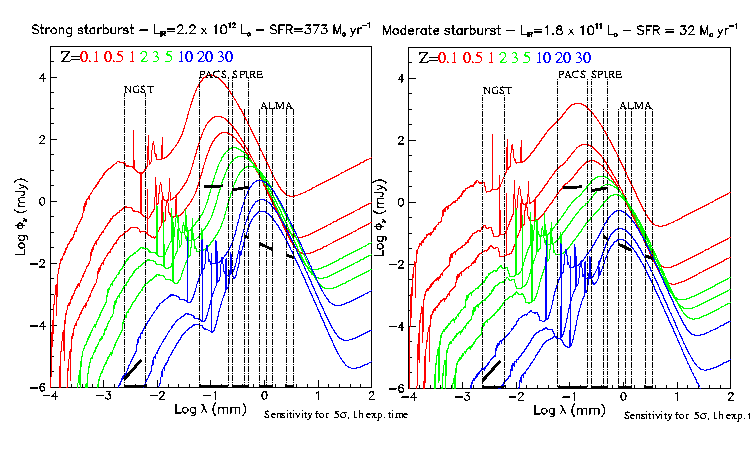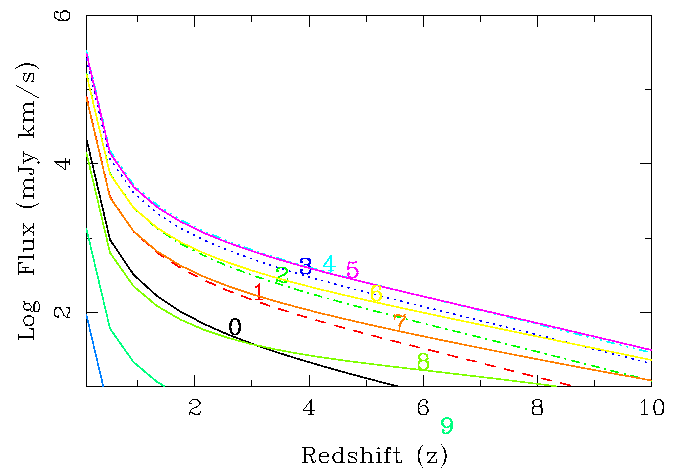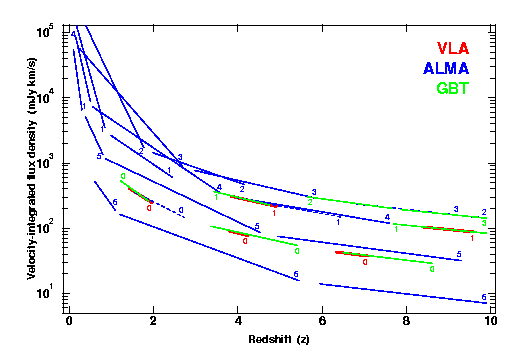 Formation and evolution of galaxies
Formation and evolution of galaxies
Detecting molecules in high-z mergers with ALMA |
 Formation and evolution of galaxies
Formation and evolution of galaxies
-> at high z, more affected
Star formation rate highly underestimated
LIR/LB varies from 0.1 to 1000 !
 |
SED for strong and moderate starbursts, at various redshifts, compared with NGST, FIRST/Herschel and ALMA sensitivities, for 1h integration time (Melchior et al. 2001). |
PRESENT SURVEYS
JCMT-SCUBA, IRAM-MAMBO at 0.850 -1.2 mm
(Smail et al 97, Barger et al 98, Carilli et al 00)
1-2 sources/ arcmin2
above 1 mJy (e.g. Carilli et al. 2001)
Problems:
 Identification of sources
Identification of sources
 Confusion (also SIRTF, ASTRO-F, Herschel)
Confusion (also SIRTF, ASTRO-F, Herschel)
 Contribution of AGN?
Contribution of AGN?
 How to get redshifts?
How to get redshifts?
By molecular lines (redshift machine)
LMT, GBT, ALMA...
Extinction corrections applied to vis/UV results correspond ( x 3)
No confusion with ALMA:
spatial resolution better than 0.1"
Possible detection of non ULIRGs
for ex. LBGs: Lyman-Break Galaxies
(Steidel et al 1996, Adelsberger & Steidel 2000)
their density is 150/arcmin2 for z=2.5-3.5
 100 times more objects than today
100 times more objects than today
Semi-analytic models, based on the hierarchical scenario
Numerous free parameters
 Much more efficient at high z
Much more efficient at high z
How to know the molecular gas fraction ?
Molecular lines: favored also at high z
but no negative K correction
Highly depend on excitation, density, temperature..
ULIRGs: observed in excited CO lines
J=8-7, 9-8, etc..
| Tel | Area | min wavelength | Resol |
| IRAM-30m | 707 m2 | 1mm | 10" |
| IRAM-PdB | 883 --> 1060m2 | 1mm | 0.5" |
| NRO | 6x10m=509m2 | 1mm | 0.5" |
| OVRO | 6x10m= 509 m2 | 1mm | 0.5" |
| +BIMA | 10x6m=282 m2 | 1mm | 0.5" |
| =CARMA | 791 m2 | 1mm | 0.5" |
| SMA | 7x6m = 200 m2 | 0.3mm | 0.1" |
| GBT | 100m = 7854 m2 | 2.6mm | 7" |
| LMT | 50m = 1963 m2 | 1mm | 6" |
| ALMA | 64x12=7238 m2 | 3-0.3mm | 0.1-0.01" |
| E-VLA | 35x25m=17200m2 | 6mm | 0.004" |
MOLECULES AT HIGH REDSHIFT
First detection: Faint IRAS Source
F10214+4724 at z=2.3
(Brown & van den Bout 1992, Solomon et al 1992)
 |
H2 mass as a function of redshift. Black triangles: normal galaxies. Empty pentagons: ULIRGs. Asterisks: high-z CO-detected objects. Dotted lines: IRAM sensitivity for various CO lines. |
Triggered the search: hyper-luminous objects, quasars..
 15 betwen z= 1.0 and 4.7 (in 2001)
15 betwen z= 1.0 and 4.7 (in 2001)
most of them amplified gravitationally
Strategy:
MODELISATION
Starburst modelisation, from z=0 ULIRGs
size 1kpc, mass 6 1010 Mo
2 extreme models:
Assuming the same energy comes from stars
Transfer: LVG model
 |
Result of the LVG model, for the homogeneous case at T=50K. Top: CO lines; Bottom: continuum as a function of redshift. |
Starbursts at high z could be different from ULIRGs at z=0
In particular, the molecular density could be less, and the rotational levels of CO not excited until J=9-10..
| T=50K | T=30K & 90K | |
 |
 |
|
| T=30K | HR10, Papadopoulos & Ivison 2001 | |
 |
 |
Molecular absorption in front of quasars will be also a useful tool to determine the chemistry as a function of z, with ALMA
 |
Several examples of molecular absorption in front of quasars, at various redshift (Wiklind & Combes) |
STARBURST DYNAMICAL SIMULATIONS
Melchior & Combes (2001)
Chemo-dynamical simulations of galaxy collisions at high z
N-body Tree-SPH
with spectral modelisation coupled to dynamics
 |
One of the first simulations, with in green the dark matter, in red the stars, and in blue the gas particules. Three projections are given at each epoch. |
Library of merging galaxies:
the missing link, baryons
star-formation and feedback
disks and angular momentum
dynamical friction..
Observations of the objects:
toward predictions for NGST, ALMA, FIRST-HERSCHEL
and before, GBT, LMT..
Continuum and lines
CONCLUSIONS
Opening of the ALMA "window"